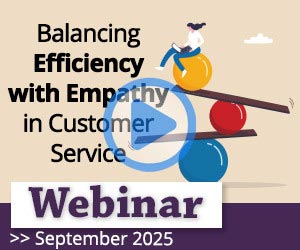We present a method for negotiating with customers, to help them get on board with your customer service resolutions.
The Opt-In Approach
It can be difficult for advisors when they put forward a solution to a customer’s problem that is not met with great enthusiasm.
Often the customer will have an idea of what they want and may not be willing to accept the advisor’s resolution when that is not possible.
Negotiation must therefore be taken on. The following acronym “OPT-IN” is a great tool for advisors to use in this situation. What it stands for is highlighted below.
Options Explored
Provide the Benefit
Tell the Reason
Instil Confidence
Next Steps
This approach – as designed and coached by Jacqui Turner, the Founder of Turner Corner Learning Solutions – is designed to get customers to listen and buy in to the advisor’s alternative solution.
Here we explain each step in more detail, so advisors can use the “OPT-IN” approach practically in the contact centre.
Step 1 – Options Explored
Don’t start with what you can’t do. Listen carefully to what the customer is ideally asking for.
“If it is impossible to deliver exactly what the customer has asked for, list the options that you can provide,” says Jacqui.
You want to start your response with what you can offer the customer. The customer is therefore instantly hearing those “we can” options, which helps to make things a little more positive.
When providing these options, think in terms of “big chunk or little chunk” – aka would the customer like to hear lots or fewer details?
We all tend to have a preference between the two. If the advisor asks themselves the following questions – when considering the customer’s responses – they can usually tell:
- Is the customer talking in terms of details or are they providing a general overview?
- Is the customer asking lots of specific questions to get more detail?
- Is their tone impatient? i.e. do they prompt you to get to the point?
For more on exploring options with the customer, read our article: Call Control Techniques: How to Present Options to Customers
Step 2– Provide the Benefit
In any negotiation, the key is in getting the customer to understand why you are offering those options and the benefit they can bring to the customer.
“Whether you work in a customer service or sales environment, the benefits have always got to be linked to the customer’s situation,” adds Jacqui.
So, after you’ve presented each option, go through and highlight the benefits, using phrasing such as:
- “Option A will enable you to…”
- “Option B does provide you with…”
To make each option specific to the customer’s situation, reflect back to the customer key things that they themselves have put forward when highlighting their intended outcome.
This skill is dependent on the advisor carefully and friendlily questioning the customer before presenting their options and using probing skills to find out what is most important to them.
For more on customer questioning and probing skills, read our article: 10 Effective Questioning and Probing Techniques for Customer Service
Step 3 – Tell the Reason
Unfortunately, you cannot ignore the customer’s original request. This is the point at which you tell them that you cannot deliver their preferred outcome.
A key part of good customer service, as Josh, one of our readers, says, is to: “Answer the question you’re asked – not the question you want to answer!”
As this is “step three” of five, this technique allows the advisor to sandwich the bad news in the middle of their statement, enabling them to start and end in a positive manner.
When telling the customer that you cannot deliver their preferred solution, it is important to give a full explanation as to why you cannot do so.
Avoid the “Company Policy” Excuse
Don’t tell the customer that “It’s company policy.” Even if this is the case, this phrase can make the advisor seem uninterested and insensitive to the customer’s desired outcome.
This comes back to training advisors on why certain options can’t be given. Most of the time, advisors fall back on the phrase “It’s company policy” because they simply don’t know.
It can also be good to have a document on your contact centre’s knowledge base – for advisors to fall back on – that provides the reason why your company cannot deliver on common customer requests.
Step 4 – Instil Confidence
Language is important here. The advisor will, at this stage, reiterate the benefits to the customer once again, in a positive way that builds enthusiasm around their preferred outcome.
Use a statement like: “I’m very confident that option A is going to…” Then reiterate the benefit that was highlighted in step two.
Phrases like this can be very powerful in terms of getting inside the customer’s head in helping them see that:
- The advisor is somebody who is focused on solutions and not what they see as “excuses”
- The advisor is absolutely convinced that this is the best solution for them
Get Personal
The phrase “I’m very confident…” is great to instil confidence in the advisor’s preferred solution. Not only is “confident” a great positive word to use, the use of “I” as a personal pronoun is used to great effect.
Simon, one of our readers, encourages his team to use language like this, stating: “We encourage our advisors to use “I” and “me” rather than “we” and “us” as it conveys a greater sense of ownership of the call.”
When the advisor takes ownership of a customer’s problem and makes things personal – so the customer feels like they are talking to a real person and not a “company rep” – the customer tends to have more confidence in their point of view.
For more examples of positive words that can instil confidence, read our article: Top 25 Positive Words, Phrases and Empathy Statements
Step 5 – Next Steps
Keeping their fingers crossed, now is the time for the advisor to ask the customer: “Would you like me to proceed with this?”

“A simple yes-or-no question like this draws the customer into fully considering the advisor’s preferred solution, which they have now fully outlined,” says Jacqui.
Hopefully, the advisor has now earned the “yes” and can outline what happens next.
When the advisor is giving the customer next steps, the one important thing to remember is to include a timescale, as this will allow the customer to better plan their time. It is always good to demonstrate that you value the customer’s time.
Tying This Altogether
If you combine all of the steps above, an advisor can create a response to an undeliverable customer request that will be much better received than if they were to say: “I’m sorry, we can’t…”
For example, just take a look at the statement below, which can – to a certain extent – be templated:
“Jane, what I am able to offer you is… (Option B). This will enable you to… (provide benefit). This is, in my opinion, the best possible option as I’m unable to offer Option A due to… (provide reason). However, I am confident that the option I’ve explained will (reiterate the benefit). Would you like to go ahead with this option?”
As you can see, each of our five steps has been followed here:
- Step 1 – “Jane, what I am able to offer you is… (Option B).”
- Step 2 – “This will enable you to… (provide benefit).”
- Step 3 – “This is, in my opinion, the best possible option as I’m unable to offer Option A due to… (provide reason).”
- Step 4 – “However, I am confident that the option I’ve explained will (reiterate the benefit).”
- Step 5 – “Would you like to go ahead with this option?”
Avoid These Negotiation Killers
The phrase “It’s company policy” is, as previously stated, a bad phrase to use in a negotiation, whether that’s in customer service or sales.
Yet there are lots more examples like this, so – to finish – let’s look at three more classic words and phrases to avoid when negotiating with a customer.
- “Unfortunately…” – Encourage advisors to avoid the word “unfortunately” to begin their response to a customer’s request. Even if you move on to a positive later in that sentence, the customer may have already switched off because everybody expects bad news to follow the word “unfortunately”.
- “Can you wait on hold for a moment?” – No customer enjoys being put on hold. Nevertheless, it is sometimes necessary. So, when putting the customer on hold, make sure the customer knows why they are being placed on hold. This will minimize their frustration, stopping them from building resentment against the advisor.
- “As stated on our website…” – In this day and age, the vast majority of customers will have already checked your website. If there was any pertinent information regarding their query on there – that was easy and convenient to find – the customer would have found it. So avoid this phrase to protect from customer ill will.
For more examples of phrases to avoid like this, read our article: 15 Things a Call Centre Agent Should Never Say (But Many Do)
To find more articles on handling various customer situations, read our articles:
- How to Handle Call Escalations
- 21 Ways to Improve Complaints Handling in Your Contact Centre
- Top Tips for Building Rapport on the Telephone
Author: Robyn Coppell
Published On: 7th Apr 2021 - Last modified: 6th Jan 2026
Read more about - Skills, Call Handling, Editor's Picks, Jacqui Turner, Skill Development, Soft Skills

















